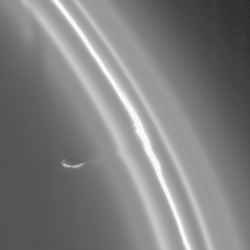
Prometheus acting on Saturn’s F ring. Image credit: NASA/JPL/SSI. Click to enlarge
One of the most amazing images sent back by the Cassini spacecraft shows one of Saturn’s shepherd moons, Prometheus, tugging a stream of particles away from the F ring. Scientists from Queen Mary, University of London have developed a model that explains the forces at work in this dramatic interaction. It was originally believed that Prometheus steals ring particles, but it now appears that it just borrows them as it comes past, and they drift back into the ring system after the moon sweeps by.
Images from Saturn’s F ring region obtained by the Cassini Imaging Science Subsystem (ISS) cameras have revealed structure never seen before in a planetary ring.
The rings around all the giant planets in our Solar System are thought to be stabilised by small ‘shepherd moons’ that orbit in or near the rings and stabilize them by gravitational influences.
The narrow F ring of Saturn ? which lies just outside the spectacular main rings – is tended by two small shepherds. Prometheus (100 km in diameter) orbits just inside the F ring, while Pandora (85 km in diameter) moves around Saturn just outside the F ring.
Periodic structures such as azimuthal gaps ? ‘channels’ of low optical depth – and ‘streamers’ have been discovered. These features can be seen in Movie1. The origin of these features has been explored by a team at Queen Mary, University of London (QMUL) using numerical integrations.
On Tuesday 4 April, Carlos Chavez of QMUL will be explaining to the RAS National Astronomy Meeting in Leicester the results of their computer models, which explain the close and complex relationship between Prometheus and the tangled F ring.
“The models are in excellent agreement with structures observed in the Cassini images,” said Chavez.
“We have found that the gaps are not due to a lack of particles, but to a forced change in orbital elements by a close encounter with Prometheus,” he explained. “The moon’s gravity temporarily pulls some of the particles away from the main stream as it passes by.”
“It is like a crowd of people walking in a number of lines in the same direction down a street. Suddenly, someone else comes from the other side of the street and collides with a few of them. He then tells them to come with him, and walks away. Only people in the closest lines follow him, which produces gaps in the crowd. However, they return back to the main group shortly afterwards.”
The most dramatic case will happen in late 2009, when the F ring and Prometheus are anti-aligned. Once per orbit during this anti-alignment Prometheus will be at apoapsis (its furthest point from Saturn) and the nearby ring particles will be at periapsis (closest point to Saturn). At that time, Prometheus and the ring particles are at their closest to each other.
The QMUL team explored how these events will affect collisions between the ring particles and Prometheus. They found a low number of collisions – only 0.6% of the particles collided per orbit. This was unexpected, since it was originally thought that Prometheus is a ‘thieving moon’, stealing particles from the F ring. What actually happens is that the particles are only temporarily pulled away and then drift back into the ring.
The ring-moon interactions are also likely to have an effect on the surface of Prometheus. Like our Moon and most other planetary satellites, Prometheus has a synchronous rotation, always showing the same face to Saturn.
The team at QMUL investigated the location on Prometheus’ surface where the particles would be expected to collide. They found that, in the synchronous co-rotating reference frame, the collisions surprisingly occurred on the trailing face of Prometheus, and preferably in the equatorial region.
This scenario has important implications for the surface features of Prometheus, and the team expects to find differences in albedo (reflectivity) between the trailing and leading faces.
“It would be like a man colliding with other people while facing continuously in a particular direction and hitting them with only one side of his body,” said Chavez.
Other members of the QMUL team examining the links between Prometheus and the F ring are: Prof. Carl D. Murray, Dr. Kevin Beurle, Dr. Nicholas J. Cooper, and Dr. Michael W. Evans.
Original Soure: RAS News Release
